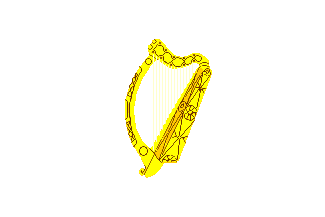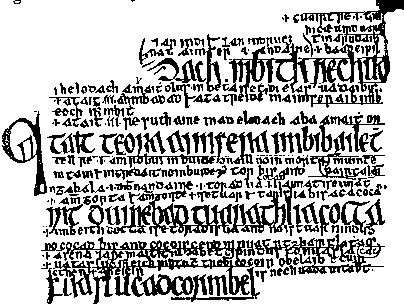| Ireland was possibly the most advanced of all European cultures: it
had an Iron Age culture which included bards, historians, judges and a set
of laws that governed all aspects of life. This voluminous set of laws covered
everything from hurting a chained dog to behavior while drinking. The set
of laws was known as the Law of the Commoner or Freemen, or the Brehon
Law.
So balanced and just was the ancient Law that it was adopted by the majority
of the Norman conquerors and held sway among the populace until ruthlessly
put down by Cromwellian forces in the 17th century.
Many suppose that the Brehons served as judges. Actually, the Brehon was
but the legal expert. His primary function was arbitration. In the event
that judgement must be forced, it was the Righ (ruler) who, in consort with
his Law Givers, gave judgement. However, even the Righ was not the final
authority. A Righ who became unpopular could be summarily voted from office.
. Ultimate control was the moral power of public opinion. Every individual
felt it his or her bound duty to ensure that their venerated Brehon Law was
upheld.
Although the age of these laws is unknown, they appear to be at least
four thousand years old, as they date back at least to the time of the
Tuatha
de Danann in Ireland. They are perhaps even older, as there is mention
among the history of Ireland that the Tuatha and the Fir Bolg people
made agreements under a law of the time. This agreement gave one side the
right to even the odds by reducing the opposing force and allowing time to
prepare weapons. Whether this agreement was based on actual Brehon Law or
just a current (at that time) common law of nations is unknown.
The practitioners of these laws were called Brehons. They were not judges
or lawyers although many consider them so. In actuality, they were arbitrators
whose responsibility it was to settle disagreements. The Brehons had to study
the laws for years before they were allowed to practice their art and this
is due in part to the size or volume of the laws that were enforced. It was
an oral code to the greatest extent, and was only written down around the
3rd Century and in later times.
Here are a few of the most interesting Brehon laws quoted from the book
of Irish Traditional Law.. Many serve to illustrate the degree of
civilization of the ancient Celts and show how once Irish society was ordered.
Some are certainly inappropriate to the modern view of a person's status,
in particular that of women.
"It is illegal to overide a horse, force a weakened ox to do excessive
work or threaten an animal with angry vehemence which breaks bones."
''There are three tresspasses of a hen in a herb garden: the
soft-swallowing of bees, injury to the dye plants, and attacks on the garlic.
A guilty hen shall have her feet tied together, or rag boots put on."
''At the main feast of the assembly the king and the chief poet of
the tribe shall be served a thigh of the roast. The young lord is served
a leg. Blacksmiths and charioteers shall be served the head and queens get
haunches.''
''The wife who minds the sheep shall be paid two lambs a year.''
''The chief poet of the tribe earns twenty-one cows annually, plus enough
pasture lands to feed them, plus two hounds and two horses.''
''If a person who is of a higher rank than you refuses to pay his debt
you may sit at his doorstep and fast until he submits to arbitration. If
you die before he submits he shall be blamed for your death and shall suffer
lifelong disgrace.''
''Whether the offspring of kings, warriors, poets, workers in
wood or stone, or tillers of the soil, a son or daughter shall follow the
career of his or her parents.''
''...the son of a king of Erin shall wear satin and red
clothes...''
''The sons of the inferior classes of chieftains shall wear black,
yellow, or gray clothing..."
''The sons of the lowest class of chieftain shall wear old
clothes...''
''A king exercises not falsehood nor force nor oppressive might. He
is righteous towards all his people, both weak and strong.''
"Three things that cause the overthrow of a king; injustice, extortion,
and kin-slaying.''
''For digging in a churchyard to steal from it, for making a dam in
a stream to take an excess of fish, or for stealing a hunter's tent, your
cattle will be taken to the animal pound for three to ten days, depending
on the circumstances.''
''If a tribesman breaks another tribesman's leg he must pay a fine
and supply a horse for the victim to ride on.''
''All members of the tribe are required to offer hospitality to strangers.
The only exceptions are minor children, madmen, and old people.''
''The selfish man, who thinks only of his cows and his fields, and
not of his fellow human beings, may be insulted without risking a blush
fine.''
''The satirist who satirises a guiltless person will grow blisters
on his own face. And then he will die.''
Every third year roads must be cleared of brambles, brush, weeds, and
water to make ready for the great assembly, feast/fair.
The creditor who holds your brooch, necklaces and, rings as security
for your pledge must return them back to you to wear at the great assembly
and prevent embarrassment.
For the best arable land the price is 24 cows. The price for dry, coarse
land is 12 dry cows.
If a woman makes an assignation with a man to come to her bed or behind
a bush the man is not guilty of rape even if she screams. If she has not
agreed to the meeting, however, he is guilty as soon as she screams.
The groom shall pay a bride-price of cattle, land, horses, gold, silver,
to the Father of the bride. Husband and wife retain individual rights to
property, goods and possessions each bring to the marriage.
If a pregnant women craves a morsel of food and her husband withholds
it through stinginess, meanness or neglect he must pay a fine.
A fine of 6 cows for breaking a tribesman's two front teeth; 12 heifers
for maiming a homeless man. For pulling off the hairs of a virgin Bishop
one yearling for each 20 hairs.
It is illegal to give someone food in which a dead weasel or mouse
has been found.
If your neighbor does not repay the debt he owes you, you may prevent
him from going about his daily business. A withe-tie goes around the blacksmith
anvil, carpenter's axe or tree fellers hatchet. He is on his honor to do
no work until the debt is settled or wrong righted. If a Bard or physician
is the debtor immobilize his horse whip for both ride their circuits. The
creditor may fast in front of the debtor's house to humiliate him until the
debt is paid.
If a rational adult brings a simpleton into an ale house for amusement
and the simpleton injures a patron the adult who brought him must make
compensation.
The blacksmith must rouse all sleeping customers before he puts the
iron in the fire to guard against injury from sparks. Those who fall asleep
again will receive no compensation.
When a judge deviates from the truth, a blotch will appear on his cheek.
Whoever comes to your door, you must feed him or care for him, with no questions
asked.
The chief poet of the tribe shall sit next to the king at a banquet.
Each shall be served the choicest cut of meat.
The poet who overcharges for a poem shall be stripped of half his rank
in society.
The mill-owner is exempt from liability for injury to a person caught
between the millstones.
The husband who, through listlessness, does not go to his wife in her
bed must pay a fine.
If a pregnant woman craves a morsel of food and her husband withholds
it through stinginess or neglect, he must pay a fine.
A layman may drink six pints of ale with his dinner, but a monk may
drink only three pints.
This is so he will not be intoxicated when prayer-time arrives.
If the poet or the physician is in debt, immobilize his horse-whip,
for both ride their circuits on the backs of horses.
The lender of a horse must give notice of the horse's kicking habits.
Notice of the hound in heat and the mad dog must be sent to the four
nearest neighbourhoods.
The harpist is the only musician who is of noble standing. Flute-players,
trumpeters and timpanists, as well as jugglers, conjurers and equestrians
who stand on the backs of horses at fairs, have no status of their own in
the community, only that of the noble chieftain to whom they are attached.
The creditor who holds your brooch, your necklet or your earrings
as a pledge against your loan must return them so you may wear them at the
great assembly. Or he will be fined for your humiliation.
The time allotted to each Brehon for pleading his case is long or
short according to his dignity. In determining the length of the speech he
is allowed, count eighteen breathings to the minute.
On the best land everything is good. The herbs are sweet and no manure
or shells are needed. There will be no plants that will stick in a horse's
mane or tail: no briars, no blackthorns, no burdocks.
With the arrival of
St.
Patrick in Ireland, the laws were collected from all over the country
and reviewed. Some of the laws were then stricken if they ran contrary to
the laws of God. Those that remained were copied down for succeeding generations
and continued in use until the English gained total control of Ireland in
the 16th Century.
Sadly a large portion of these laws are now lost, as only a portion of
the volumes can be found. Of those that remain, they sit in a limbo of sorts.
They have been copied down in their original form, but much of this work
is in Old Irish, and has not yet been translated. Efforts are underway to
correct this by a group called Brehon Aid, which hopes to get the
funding and the human resources to complete this monumental task.
|

